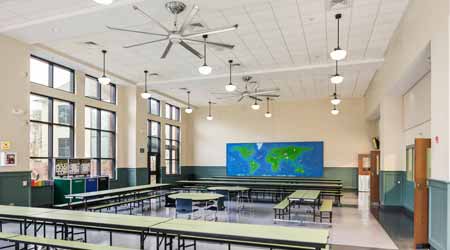« Back to Facilities Management HVAC Category Home
Reign in Heating and Cooling Costs with HVLS Fans
August 11, 2016
- HVAC

By Josh Corman
Facility managers know that heating and cooling costs can quickly spiral out of control. Contemporary design elements — high ceilings, expansive windows, and open floor plans, for example — contribute to these ballooning expenses. So does the need to keep employees productive and guests comfortable.
High-volume, low-speed ceiling fans ceiling fans can play a key role in reducing costs year-round without sacrificing occupant comfort. These large-diameter fans use their size — not speed — to effectively and efficiently circulate conditioned air in large spaces. While fans are well-known to provide a cooling effect in warmer months, they also offer great savings potential in winter.
Give the A/C a Break
During summer months, a well-air conditioned space can feel like a million bucks. Unfortunately for facilities managers, air conditioning sometimes seems that costly. HVLS fans, however, can lower summer cooling costs by reducing reliance on HVAC systems.
The air movement produced by HVLS fans creates a perceived cooling effect of up to 10 degrees F, which means that, even if thermostats in a given space are set several degrees higher than normal, occupants will still feel comfortable. The small change can make a big difference since each degree a thermostat’s set point is raised corresponds to around a 3 to 5 percent reduction in cooling costs.
Lower energy bills aren’t the only benefit to using fans in concert with a facility’s cooling system. HVLS fans improve air quality by more thoroughly mixing the air inside a space. Rather than simply replacing air at vent-level, these fans provide complete air turnover. And, although hard to calculate, increasing the comfort of occupants can increase productivity.
Fans in Winter? Absolutely
The hot air poured into buildings during cold months is less dense than the cooler air already in place. As a result, the hot air rises, leaving temperatures at floor level drastically lower than at the ceiling. Heating systems try to compensate for this temperature discrepancy by pumping even more hot air into the space. The hot air rises once again, collecting uselessly above the people it’s meant to keep warm, and the cycle of waste continues.
To combat this, HVLS fans gently push to occupant level the warm air that has gathered at the ceiling, creating consistent temperatures throughout the space in a process known as destratification. As a result, heating systems operate more efficiently, employees stay comfortable and productive, and utility costs shrink.
The Bottom Line
Cost-conscious facilities managers simply can’t afford to throw away money on wasteful and inefficient heating and cooling solutions. Luckily, HVLS fans offer a simple way to create energy-saving air movement in buildings of nearly any size and layout.
Josh Corman is a writer for Big Ass Solutions, the parent company of Big Ass Fans, Big Ass Light, and Haiku Home. Based in Lexington, Kentucky, Big Ass Solutions manufactures, sells and installs comfort equipment and LED lighting.








